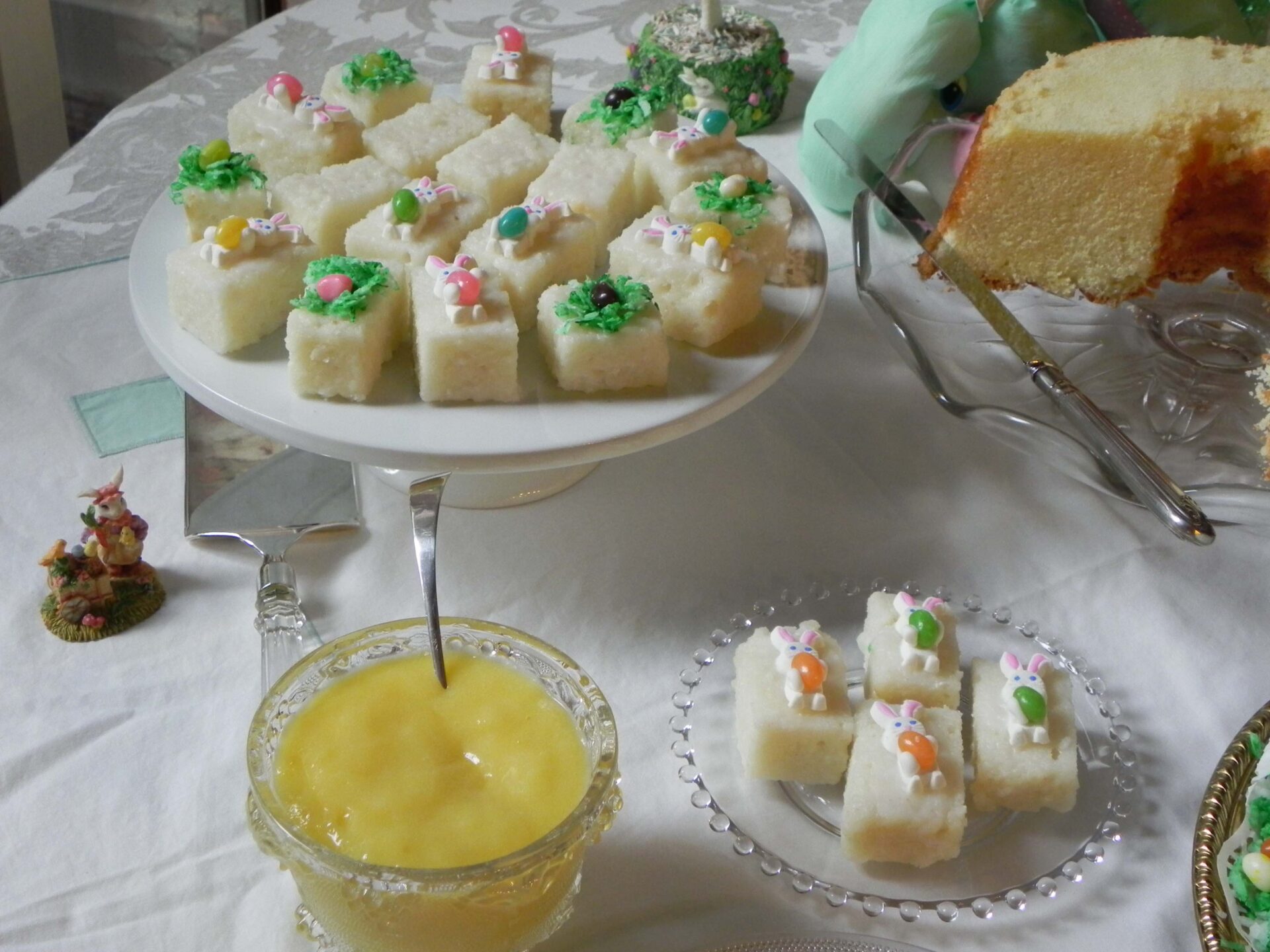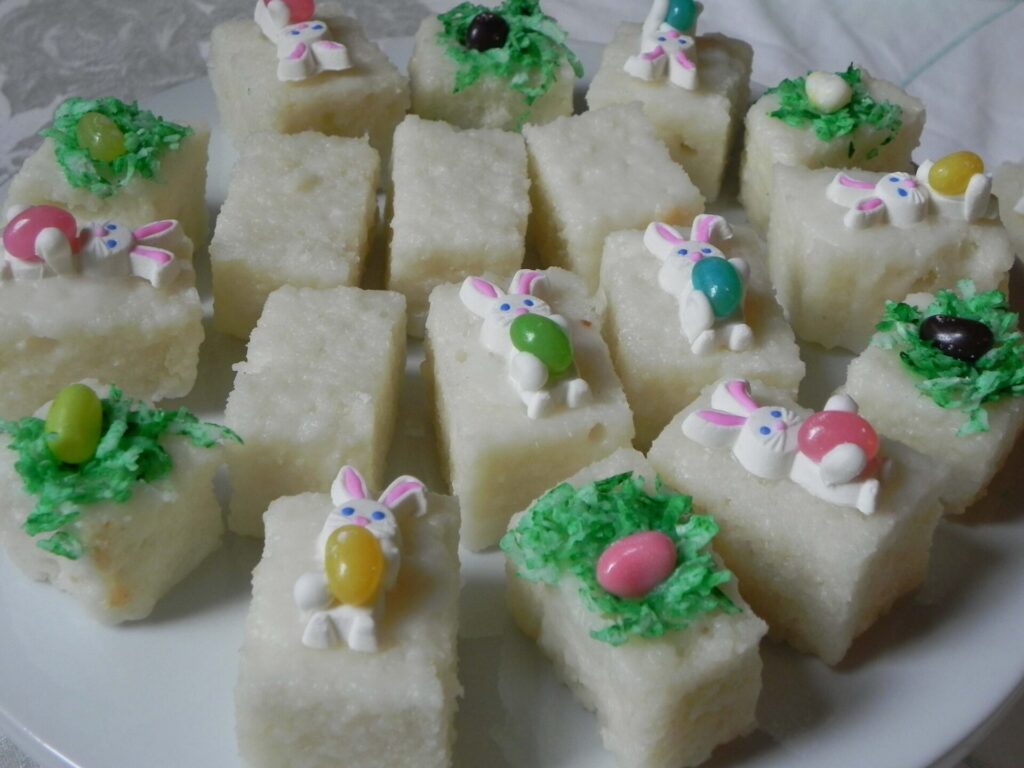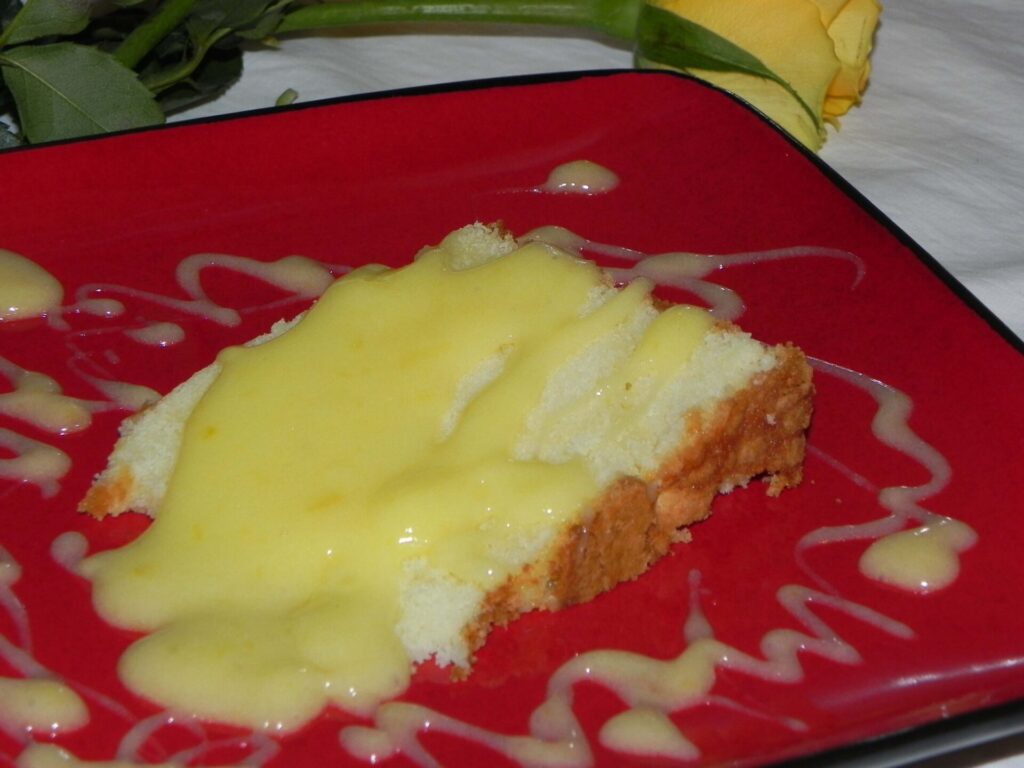
By Laurie Triplette
ldtriplette@aol.com
Southernism of the Week:
Well slap me silly! … and call me Susan (or Sally or Darlin’… ): An upbeat expletive related to Butter my butt and call me a biscuit! One could attribute all sorts of origins to this sort of nonsensical expletive, some of them containing sexual innuendo. But let’s take the high road (yet another saying)…. Some sayings just are what they are, and we Southerners love ‘em for their literary poetry.
JELLY BEANS, CAKE AND PETIT FOURS
Spring evokes many images and sensory triggers. Among them for some of us are citrusy foods and beverages. I don’t know why … perhaps their happy-making hues such as yellow and green just seem Spring-ish.
Nothing is more Springy to this foodie than lemon-flavored confections, except perhaps the aroma and flavor of almonds. Almonds always evoke fond personal memories of past Easter and Passover seasons in Memphis and the Delta.
This time of year, The Old Bride also thinks about jelly beans. After all, they are perfect for filling those annoying plastic Easter eggs in the Easter baskets. And jelly beans make us laugh. Seriously, jelly beans are inherently amusing. Think Harry Potter and the Hogwarts gang and their Bertie Botts’ Every Flavor Jelly Beans.
The history of jelly beans is a bit obscure. Composed of a candy shell and gel interior made of sugar, corn syrup and starch, the jelly bean requires about 21 days to create. The jelly bean is related to Turkish delight, a Middle Eastern confection of soft jelly covered with confectioner’s sugar, and to the crunchy hard sugar shell on Jordan Almonds. But don’t confuse jelly beans with Skittles or gum drops.
Jelly beans came into their own in 1861, when Boston confectioner William Schrafft urged Yankees to send jelly beans to their soldiers fighting you-know-where.
Jelly beans were the first candy to be sold in bulk by the pound weight rather than by the piece. They came in an assortment of about 8 fruit and spice flavors and colors. Cheap but satisfying, jelly beans had become the favorite penny candy for children by around 1900.
The confection was featured in the Chicago Daily News in 1905, and by about 1910 Jelly Bean had become a slang term referring to would-be “Players,” young men who dressed stylishly to appeal to young women, but who lacked character and substance. Even F. Scott Fitzgerald used the term referring to such a drugstore cowboy in a story he wrote in 1920.
Jelly Beans were intertwined with Easter by the 1930s, perhaps because their shape evokes the symbolism of eggs and fertility. The connection stuck, and today, manufacturers produce about 16 billion jelly beans annually for the Easter holiday season. Every year, they add new flavors to the mix.
Beloved worldwide, jelly beans have become part of modern American pop culture. They have been a favorite tool in community guessing games (guess how many in the jar and win…), and have been a sugar-fix crutch for past U.S. presidents. We even have a National Jelly Bean Day. This year it is April 22.
So bear with me, folks, for this week The Old Bride is decorating lemon- and almond-flavored Easter baked good with jelly beans. I could have used Peeps… but nobody would have eaten those.
CLASSIC PETIT FOURS
 This is the classic recipe containing almond extract. Feel free to modify with vanilla or lemon extract. Vanilla will darken the white cake. I suggest preparing the cake a day ahead of the icing. Also, do as I say, not as I did: Allow the icing to thicken a bit before coating the cakes in order to achieve a more glossy appearance.
This is the classic recipe containing almond extract. Feel free to modify with vanilla or lemon extract. Vanilla will darken the white cake. I suggest preparing the cake a day ahead of the icing. Also, do as I say, not as I did: Allow the icing to thicken a bit before coating the cakes in order to achieve a more glossy appearance.
Cake:
3 c all purpose flour
1 T baking powder
1/2 tsp table salt
1-1/2 c white granulated sugar
1/2 c (1 stick) salted butter, softened
6 egg whites
1/2 tsp almond extract
1 c whole milk
 Preheat oven to 350˚F. Grease and flour a 9-by-13-inch baking pan. Sift the flour, baking powder and salt into a large bowl and set aside.
Preheat oven to 350˚F. Grease and flour a 9-by-13-inch baking pan. Sift the flour, baking powder and salt into a large bowl and set aside.
Beat sugar and softened butter in mixing bowl on medium speed, scraping sides, until creamy. Add egg whites slowly (essentially one at a time), with mixer running on low speed. Increase speed to medium-high, and add almond extract. Reduce speed to low and add the flour and milk in three parts each, beating well to blend after each addition. Mix enough to remove lumps.
Pour batter into prepared pan and thump on counter several times to eliminate bubbles in the batter. Bake 30-35 minutes, until toothpick comes out clean (top of cake will be golden colored. Cool 10 minutes on wire rack. Run a sharp thin knife around the edges to loosen, jiggle to loosen from bottom of pan and carefully flip onto waxed paper to cool completely. Trim away all four edges. Use ruler to measure and cut into 48 squares (my examples in photograph are not exact). Cover until ready to complete the cakes.
Icing:
3 c white granulated sugar
1/4 tsp cream of tartar
1-1/2 c water
1 c confectioners sugar, sifted
1 tsp almond extract
3 drops of food coloring (if making pastel-colored cakes)
Whisk cream of tartar into sugar in large saucepan. Add water. Cook on medium heat, stirring regularly with wooden spoon, until mixture comes to a full boil (about 12 to 14 minutes). Cover and set timer, boiling for 3 minutes. Uncover, and insert candy thermometer into mixture. Cook until temperature reaches 226-234˚F (soft-thread stage). Takes about 15-20 minutes. Remove from heat and cool to 110˚F, NOT STIRRING AS IT COOLS. Pan will be warm on bottom to touch when it reaches this stage. Stir in confectioners sugar, extract, and optional food coloring.
Ice the Cakes:
Line a large baking sheet with waxed paper. Place wire rack on the baking sheet.
Trim away top crust off each square. Working one cake square at a time, with a large fork and a spoon, douse square in the icing, coating all sides. Place square on rack and drizzle additional icing over top if needed.
Before icing sets up, decorate tops of cakes with candy flowers or bunnies; or make a small birds nest on top with a sprinkle of coconut and a jelly bean. NOTE: Color the coconut with 3 drops of green food coloring and allowed it to dry before handling.
If the icing becomes too thick to drizzle, reheat over low heat about 2-3 minutes until it thins out again.
COUSIN POLLY’S COLD OVEN LEMON POUND CAKE
Similar versions of this classic cold oven pound cake have been popular across the South for generations. The essential element is DO NOT OPEN THE OVEN once cake starts baking. You may wish to decorate the top of the pound cake with a glaze or with lemon sauce and shredded coconut. It’s excellent without any embellishments.
2 sticks butter (1 c)
1/2 c vegetable shortening
3 c white granulated sugar
1 c milk
5 eggs
3 c all purpose flour
1/4 tsp baking powder
1 tsp lemon extract
1 tsp vanilla extract
Prepare tube pan by lightly greasing with shortening and dusting bottom with flour. Cream butter, shortening and sugar. Add eggs, until light and fluffy.
Sift flour and baking powder. Add flour mixture and milk to the creamed sugar mixture in thirds until well blended. Add flavorings and mix well.
Pour into prepped tube pan and smooth out the top. Put on middle rack in a cold oven. Turn oven on to 325˚F, and bake 1 hour and 25 minutes; OR at the end of 1 hour, raise temperature to 350˚F and continue baking an additional 20-30 minutes (I do this because my ovens bake slow). DO NOT OPEN OVEN DURING BAKING.
Remove to rack to cool for 15 minutes. Run sharp thin knife around exterior and interior edges to loosen. Jiggle to loosen from bottom, and flip onto cake plate. Do not allow to completely cool in the pan or cake will stick to the bottom of pan.
LEMON SAUCE
 I used the egg yolks left over from the petit fours recipe to make this lemon sauce, which is thicker and more opaque than whole-egg lemon sauce. It works equally well chilled as a pudding in individual serving cups, or used as lemon curd filling in cakes and pastries.
I used the egg yolks left over from the petit fours recipe to make this lemon sauce, which is thicker and more opaque than whole-egg lemon sauce. It works equally well chilled as a pudding in individual serving cups, or used as lemon curd filling in cakes and pastries.
3 c white granulated sugar
5 T all purpose flour
6 egg yolks
1 large egg
2 T water
3 c boiling water
Juice and zest (grated rind) of 1 large lemon
Pinch of salt
In mixing bowl, mix egg yolks, egg, and 2 T water, whisk together the flour and sugar, and beat into the eggs.
Bring water to boil in a kettle (easier for pouring into measuring cups). With mixer running, measure water one cup at a time into heat-proof measuring cup, and add boiling water slowly in a fine stream to the egg batter. The mixture will become very thin and light colored.
Mix in the pinch of salt, lemon juice and zest.
Pour into large saucepan and cook on medium-low, stirring slowly, until mixture thickens, about 10-15 minutes. Do not allow to achieve a hard boil.
Remove from heat. Serve hot on pound cake, and store leftovers in a large covered container in fridge. The lemon sauce will set up as a soft pudding. Yields about 8 cups.
LEMON COCONUT CAKE
 Honestly, this recipe would work easily with two boxed vanilla cake mixes. The elegant twist comes from adding homemade lemon sauce filling and seven-minute icing. But if you insist on working from scratch, here goes.
Honestly, this recipe would work easily with two boxed vanilla cake mixes. The elegant twist comes from adding homemade lemon sauce filling and seven-minute icing. But if you insist on working from scratch, here goes.
Cake:
1 c (2 sticks) butter, softened
2 c white granulated sugar
4 large eggs
3 c all-purpose flour
2 tsp baking powder
1 tsp table salt
1 c buttermilk
1 tsp vanilla extract
1/2 c lemoncello
1 c prepared lemonade
16-oz bag sweetened, shredded coconut
Cream butter and sugar until light and fluffy. Add eggs, one at a time, beating well after each addition. Sift flour with baking powder and salt. Add to creamed mixture alternately with milk, beating well after each addition. Blend in flavorings. Pour batter into 3 greased and floured 9-inch cake pans lined with greased and floured parchment. Bake at 350˚F for 18 minutes, until done. Cool completely. Combine lemoncello and lemonade in a small bowl and set aside.
Seven Minute Icing:
3 egg whites
3/4 c white granulated sugar
3/4 c light corn syrup
1 T water
1/2 tsp vanilla extract
Combine all ingredients except vanilla in a double boiler, place over boiling water (make sure the top of the water does not touch the bottom of the double boiler bowl). Cook about 7 minutes, beating constantly with an electric mixer. Remove from heat and stir in vanilla. YIELD: Frosting for a 9-inch cake.
When ready to finish cake, position first layer of cake on cake plate. Poke holes evenly across top with a toothpick. Pour a third of the lemoncello mixture over the top. Slather with about 1 c of lemon sauce (see recipe above for lemon pound cake). Position second cake layer over this. Repeat. Position third layer over second. Repeat the lemoncello mixture but do not add lemon sauce.
Slather top and sides of cake with Seven Minute icing, working quickly before the icing sets up (it becomes like a marshmallow). Sprinkle coconut over top and along sides. Refrigerate cake until ready to serve.
Laurie Triplette is a writer, historian, and accredited appraiser of fine arts, dedicated to preserving Southern culture and foodways. Author of the award-winning community family cookbook GIMME SOME SUGAR, DARLIN’, and editor of ZEBRA TALES (Tailgating Recipes from the Ladies of the NFLRA), Triplette is a member of the Association of Food Journalists (AFJ),Southern Foodways Alliance (SFA) and the Southern Food and Beverage Museum (SOFAB). Check out the GIMME SOME SUGAR, DARLIN’ web site: www.tripleheartpress.com and follow Laurie’s food adventures on Facebook and Twitter (@LaurieTriplette).

